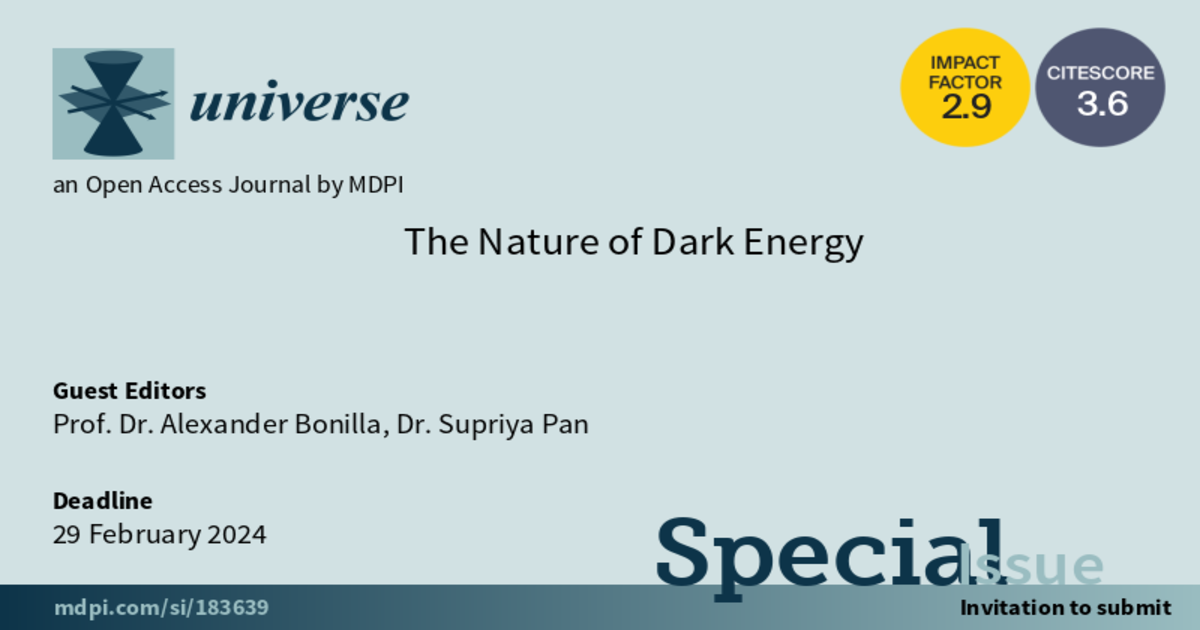The Nature of Dark Energy
A special issue of Universe (ISSN 2218-1997). This special issue belongs to the section "Cosmology".
Deadline for manuscript submissions: 31 July 2024 | Viewed by 742

Special Issue Editors
2. Facultad de Ciencias, Departamento de Matemáticas, Universidad El Bosque, Ak. 9 # 131 A - 2, Bogotá, Colombia
Interests: gravitation; cosmology; particle astrophysics
Interests: theoretical and observational cosmology; dark energy; modified gravity theories; matter creation; massive neutrinos
Special Issues, Collections and Topics in MDPI journals
Special Issue Information
Dear Colleagues,
At present, dark energy remains one of the great mysteries of the universe that continues to challenge both theoretical and observational cosmologists, from the point of view of more fundamental physics, with key questions arising, e.g., what it is made of? It is well known that the standard model of cosmology has been very successful in explaining different characteristics of the evolution and dynamics of the universe with respect to its very good fit to different types of observational data. However, it is also well known that this simple but successful model does not answer fundamental theoretical questions related precisely to the fundamental physics of the dark sector, such as: the fine-tuning problem of the cosmological constant and the energy problem of the cosmological and quantum vacuum. From an observational point of view, it is well known that tensions and anomalies are present in the several observational data sets, which have been pointed out in the last decade, such as the rate of expansion and growth of structure in the universe, and also the measurement of the anisotropies of the cosmic background radiation. These highly significant statistical inconsistencies and theoretical problems give us hints of systematic problems in the observational data or entirely new physics beyond the standard model of cosmology and particle physics, that are totally related to the fundamental character or nature of dark energy.
From a theoretical point of view, we know that the standard model of cosmology is based on three basic assumptions, namely: the validity of general relativity as theory of gravitation, a component of dark energy represented by the cosmological constant and the cosmological principle, which establishes a scale of homogeneity and isotropy in the large-scale structure of the universe. Testing these theoretical foundations is essential and this is how a plethora of cosmological models have emerged, including: modified gravity models, different types of dark energy parameterizations, including interaction models (DM/DE), holographic models of the universe where gravity can be an emergent property and not a fundamental force, among others.
From an observational point of view, it is possible to examine the standard model of particle physics and beyond, making an injection of energy in the early Universe in order to resolve or at least alleviate the aforementioned cosmological tensions, introducing new relativistic degrees of freedom in the form of right-hand and sterile neutrinos, dark bosons, dark radiation and gravitational waves that bring new physics such as: phase transitions, domain walls, inflation fields, primordial black holes, graviton stochastic background, among others. Aligned with this search, it is also important to mention the importance of multi-messenger astronomy and of observational projects that will begin to collect data in the near future the next generation of experiments like LSST, CMB-S4, CORE, e-LISA, EINSTEIN TELESCOPE, DECIGO, EUCLID, LSST, SKA, DUNE, KATRIN, XENON100, among others, will achieve unprecedented precision, which will provide a dramatic leap forward in our understanding of the fundamental nature of space and time, dark energy, baryogenesis/leptogenesis, CP- Problem, among many other loose things.
Finally, it is important to point towards new statistical inference techniques such as machine learning, which has the advantage of, on the one hand, being an independent model and, on the other, being able to handle large amounts of data and high precision in signal processing, which is important to rule out systematics.
Prof. Dr. Alexander Bonilla
Dr. Supriya Pan
Guest Editors
Manuscript Submission Information
Manuscripts should be submitted online at www.mdpi.com by registering and logging in to this website. Once you are registered, click here to go to the submission form. Manuscripts can be submitted until the deadline. All submissions that pass pre-check are peer-reviewed. Accepted papers will be published continuously in the journal (as soon as accepted) and will be listed together on the special issue website. Research articles, review articles as well as short communications are invited. For planned papers, a title and short abstract (about 100 words) can be sent to the Editorial Office for announcement on this website.
Submitted manuscripts should not have been published previously, nor be under consideration for publication elsewhere (except conference proceedings papers). All manuscripts are thoroughly refereed through a single-blind peer-review process. A guide for authors and other relevant information for submission of manuscripts is available on the Instructions for Authors page. Universe is an international peer-reviewed open access monthly journal published by MDPI.
Please visit the Instructions for Authors page before submitting a manuscript. Submitted papers should be well formatted and use good English. Authors may use MDPI's English editing service prior to publication or during author revisions.
Keywords
- modified gravity
- dark energy parameterizations
- holographic models and emergent gravity
- inhomogeneous and anisotropic models
- injection of energy in the early universe
- dark bosons, dark radiation and dark matter models
- machine learning and inference methods
- new observational facilities






